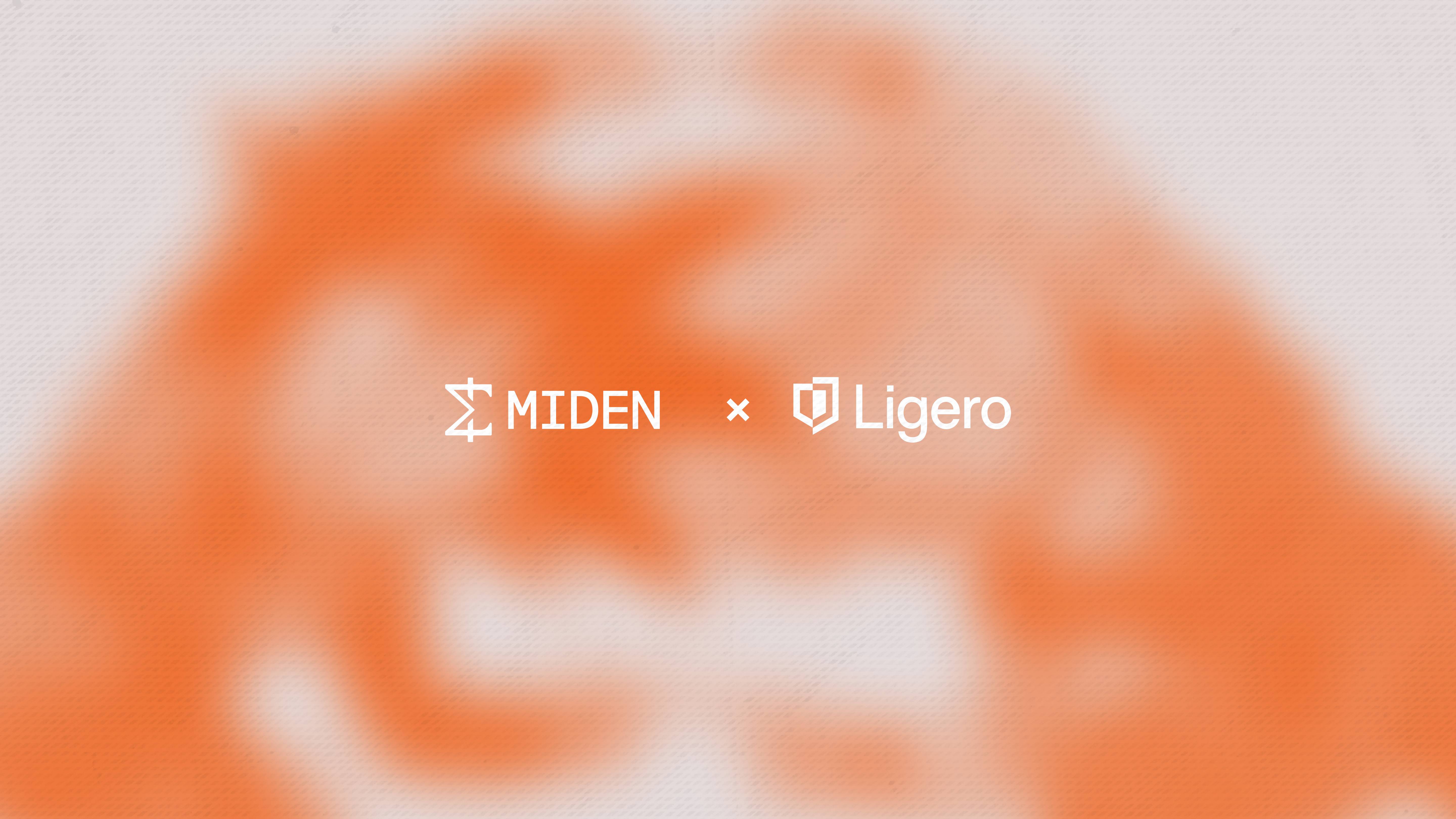- ↵Go back
- Miden × Ligero: A Stronger Privacy Stack for Real-World Finance
- Q1. What is Ligero, and why does it matter?
- Q2. How are Miden and Ligero working towards a full privacy stack?
- Q3. What does this collaboration unlock for builders and institutions?
- Q4. How does this improve security?
- Q5. What does this mean for enterprises and regulators?
- Q6. What are the most important use cases this enables?
- Q7. Isn’t this just niche cryptography for Web3 nerds?
Miden × Ligero: A Stronger Privacy Stack for Real-World Finance

To achieve privacy, scalability and compliance, no single piece of technology is enough; you need a stack. That is why Miden is partnering with Ligero.
By combining Miden’s local execution model with Ligero’s advanced proving system, we create stronger security and greater scalability, which paves the way toward genuinely private financial applications that institutions can actually use.
Let’s answer some key questions about this partnership.
Q1. What is Ligero, and why does it matter?
Ligero, founded in 2018, named after the Ligero system published in 2017 and invented by the founders, builds high-performance proving systems for zero-knowledge cryptography with the strongest provable security. Its technology lets devices (from phones to browsers) generate complex proofs locally, instead of relying on heavy infrastructure.
This is key for both privacy and security. It has also been battle-tested: Google has already adopted Ligero’s cryptography in Google Wallet, a strong signal this is not niche research.
Q2. How are Miden and Ligero working towards a full privacy stack?
Ligero strengthens Miden’s model for proof generation. Miden already runs on a client-side architecture, where proofs are generated locally and verified onchain. Ligero takes this further, offering a faster and more efficient proving system – with the goal of proving Miden transactions in around one second on mobile or in the browser (down from today’s 10-15 seconds). By integrating Ligero’s prover alongside Miden’s, the stack gains both diversity and cutting-edge techniques that have already been validated by Google.
Together, this strengthens the full privacy stack – from device to chain – and pushes it further toward enterprise-grade applications. In other words: Miden is the onchain layer and Ligero strengthens the client-side layer.
Q3. What does this collaboration unlock for builders and institutions?
Three things stand out:
- Scalability: More efficient proof generation and verification, even for complex workloads.
- Compliant privacy / programmable compliance: Two terms for the same idea. For Miden, it is compliant privacy. For Ligero, it is programmable compliance. In practice, both mean the same: private transactions that can still respect regulatory frameworks, where compliance can be encoded into the system and adapted as rules evolve.
- Security: This is the main added value of the collaboration, and it is enabled by three pillars, which we detail in the next question.
Q4. How does this improve security?
- Cryptographic strength: Ligero contributes a prover with advanced mathematical guarantees, which is why Google adopted it for Google Wallet’s cryptography.
- Diversity of proving systems: Miden’s roadmap is to support multiple provers to mitigate systemic risk from potential bugs or vulnerabilities, similar to Ethereum’s diversity of clients. This collaboration is a first step in that direction.
- Edge blockchain design: Miden's model (the "edge blockchain") executes proofs locally on user devices. A stronger proving system, focused on client-side proving and privacy, makes this edge model even more robust, ensuring sensitive information never leaves the device while verification remains efficient onchain.
Q5. What does this mean for enterprises and regulators?
Enterprises expect compliance and institutional-grade privacy. Regulators expect KYC and AML controls. This collaboration ensures both, without giving up confidentiality. With programmable rules, compliance logic can be adapted to different jurisdictions: the United States, European Union, Asia, Latin America, and so on.
With the U.S. passing landmark digital asset legislation such as the GENIUS Act, this privacy technology is well timed to ensure that institutions can take advantage of advanced blockchain technology.
Q6. What are the most important use cases this enables?
Miden is focused on the following entry-points for adoption:
- Payroll automation: private salary payments at scale.
- Private OTC trading: institutions can move size without exposing strategies.
- Compliant privacy pools: privacy pools that regulators can accept, unlike today’s black-box mixers.
- Cross-border payments: a transaction between San Francisco and Bangalore can be fast, private, and compliant.
Q7. Isn’t this just niche cryptography for Web3 nerds?
No. Miden already supports client-side proving, and Ligero’s techniques make it stronger and more scalable. Google has implemented Ligero’s cryptography in Google Wallet, a clear sign of mainstream trust.
Enterprises are exploring private payroll and payments today. And the broader privacy stack is coming together: Miden onchain, Miden client-side, Ligero’s prover as an additional layer, and a growing set of use cases in between.
These are not abstract possibilities. These are the concrete applications Miden is advancing with builders and institutions.
Privacy is no longer a side feature. With Miden and Ligero, it is the foundation of financial applications that scale.